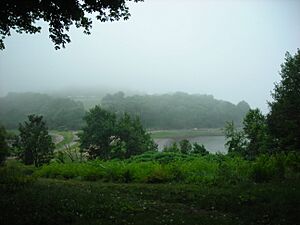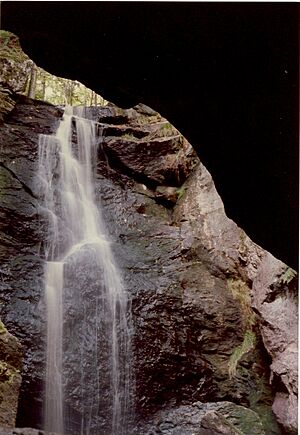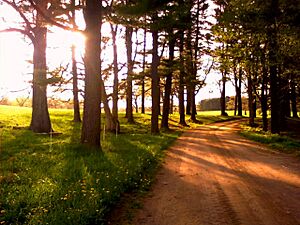The Trustees of Reservations facts for kids
 |
|
| Motto | Find your place. |
|---|---|
| Established | 1891 |
| Founder | Charles Eliot |
| Headquarters | Holyoke, Sharon, Beverly, and Leominster, Massachusetts, USA |
|
Membership (2016)
|
125,000 |
|
Acting President
|
Jocelyn Forbush |

The Trustees of Reservations is a special group that works to protect beautiful natural areas and important historical places in Massachusetts. It's a non-profit organization, which means it doesn't aim to make money, but rather uses its funds to help its cause. It's the oldest group of its kind in the world, started way back in 1891!
This organization has over 140,000 members. Besides taking care of land, they also work with other groups, support local farms (called CSA), teach people about nature, and help communities grow in a good way. They even promote "green building" which means constructing buildings that are good for the environment.
The Trustees of Reservations own 120 places covering over 27,000 acres in Massachusetts. All these places are open for everyone to visit! They also help protect over 200 other places. These spots include old mansions, lovely gardens, peaceful woodlands, waterfalls, mountain peaks, wetlands, rivers, coastal areas, beaches, farms, and even places where old artifacts have been found.
The main offices for the Trustees are in Beverly, Leominster, and Sharon, Massachusetts. They get money from members, donations, and fees from visitors. In 2006, their Doyle Conservation Center in Leominster was recognized for being a great example of green building. In 2014, another group called the Boston Natural Areas Network joined forces with the Trustees.
Contents
How Did The Trustees Start?
The idea for The Trustees of Reservations came about in 1890. A smart landscape architect named Charles Eliot wrote a letter suggesting that beautiful natural spots near cities should be saved. He thought there should be a non-profit group to hold land for the public to enjoy, just like a library holds books or a museum holds art.
In 1891, the Massachusetts government agreed! They created The Trustees of Public Reservations to buy, keep, and open "beautiful and historic places" for everyone to enjoy. The word "Public" was later removed in 1954 to avoid confusion with places owned by the government.
The first place The Trustees acquired was Virginia Wood in Stoneham. This land was later given to the state and is now part of the Middlesex Fells Reservation. Another early protected area, Waverly Oaks, also became part of the state's Beaver Brook Reservation.
In 1925, The Trustees worked with other conservation groups to talk about the need for "Open Spaces." This led to a report in 1929 that stressed how important it was to protect the state's natural beauty. Today, almost every place mentioned in that report is now protected by a government or non-profit group.
What Do The Trustees Do?

The main goal of The Trustees of Reservations is to "preserve, for public use and enjoyment, properties of exceptional scenic, historic, and ecological value in Massachusetts." This means they want to save special places that are beautiful, historically important, or good for nature, so everyone can visit and enjoy them.
Special Projects and Programs
The Trustees have several cool programs:
- The Putnam Conservation Institute: This program helps people who work in land conservation. It offers workshops and chances to meet others who are saving land, protecting parks, or working with rivers.
- The Highland Communities Initiative: This project works with small towns in The Berkshires mountains. They help protect the local culture and landscapes, making life better for the people who live there.
- The Doyle Conservation Center: This building in Leominster is a great example of "green architecture." It's a regional office, conference center, and education hub. The building uses special features like solar panels, energy-efficient lighting, and recycled materials. It even has desks made from sunflower seeds!
Working Together to Protect Places
The Trustees often team up with government groups, local communities, and private organizations to protect land. Here are some examples:
- Copicut Woods: This forest is part of a larger protected area in southeastern Massachusetts, covering over 13,600 acres.
- Slocum's River Reserve: This area protects riverfront land and farms, thanks to teamwork between the state, The Trustees, and a local land trust.
- The Tully Trail: This 22-mile long hiking trail in northern Worcester County was created by many groups working together, including The Trustees and the National Park Service.
- Appleton Farms: Located in Ipswich, this is one of the oldest working farms in the country. It's a CSA project where people can get fresh food, and it's also a place for recreation and nature preservation. They even have educational programs for kids and adults!
The Trustees are also working on projects like protecting the Mount Tom Range and developing the birthplace of suffragist Lucy Stone in West Brookfield, Massachusetts.
Amazing Places to Visit

The Trustees of Reservations own and manage many different kinds of properties across Massachusetts. Many of these places have historic buildings, including nine historic house museums and two lighthouses that you can visit!
They manage five National Historic Landmarks (very important historical places), one National Natural Landmark (a very important natural place), and many properties listed on the National Register of Historic Places. They also help manage the U.S. Army Corps of Engineers' Tully Lake Campground and other local properties. Some of their properties even extend into Connecticut and Vermont.
Here are some of the cool places you can visit:
- Bartholomew's Cobble in Sheffield: This place is a National Natural Landmark because it has the most different kinds of fern species in North America!
- Crane Beach and the Castle Hill mansion in Ipswich: A beautiful beach and a historic mansion that is a National Historic Landmark.
- Doane's Falls and Royalston Falls in Royalston: Popular waterfalls perfect for exploring.
- Cape Poge Wildlife Refuge: A barrier island on Martha's Vineyard that protects wildlife.
- The Old Manse in Concord: A historic house made famous by the writer Nathaniel Hawthorne.
- Naumkeag in Stockbridge: A grand historic mansion from the "gilded age" and a National Historic Landmark.
- World's End in Hingham: A coastal park on Boston Harbor that was designed by the famous landscape architect Frederick Law Olmsted.
- Dinosaur Footprints in Holyoke: A rock face with 134 footprints from Triassic dinosaur species!
- Moose Hill Farm in Sharon and Cormier Woods in Uxbridge are some of their newest protected areas.



